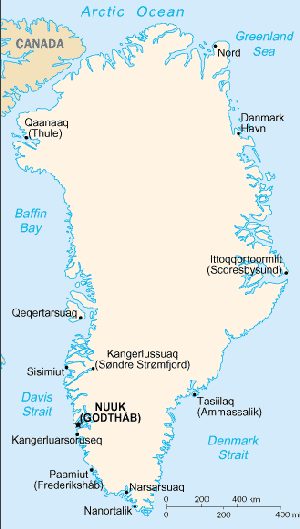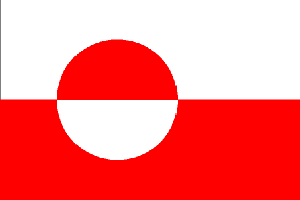
|

Greenland
Background:
The world's largest non-continental island, about 84% ice-capped, Greenland was
granted self-government in 1978 by the Danish parliament. The law went into
effect the following year. Denmark continues to exercise control of Greenland's
foreign affairs.
Location:
Northern North America, island between the Arctic Ocean and the North Atlantic
Ocean, northeast of Canada
Area: Total: 2,166,086 sq km, land: 2,166,086 sq km (410,449 sq km ice-free,
1,755,637 sq km ice-covered).
Area - comparative: Slightly more than three times the size of Texas
Coastline: 44,087 km.
Climate and Terrain:
Climate: Arctic to sub arctic; cool summers, cold winters.
Terrain: flat to gradually sloping icecap covers all but a narrow, mountainous,
barren, rocky coast
Elevation extremes: Lowest point: Atlantic Ocean 0 m, highest point: Gunnbjorn
3,700 m.
Natural resources: Zinc, lead, iron ore, coal, molybdenum, gold, platinum,
uranium, fish, seals, whales, hydropower, possible oil and gas.
Land use: Arable land: 0%.
People:
Population: 56,376.
Ethnic groups: Greenlander 88% (Inuit and Greenland-born whites), Danish and
others 12%.
Religions: Evangelical Lutheran.
Languages: Greenlandic (East Inuit), Danish, English.
Government:
Dependency status: Part of the Kingdom of Denmark; self-governing overseas
administrative division of Denmark since 1979.
Government type: Parliamentary democracy within a constitutional monarchy.
Capital: Nuuk (Godthab).
Economy overview:
The economy remains critically dependent on exports of fish and substantial
support from the Danish Government, which supplies about half of government
revenues. The public sector, including publicly owned enterprises and the
municipalities, plays the dominant role in the economy. Despite several
interesting hydrocarbon and minerals exploration activities, it will take
several years before production can materialize. Tourism is the only sector
offering any near-term potential, and even this is limited due to a short
season and high costs.
GDP: purchasing power parity - $1.1 billion.
Statistics:
Telephones - main lines in use: 25,617.
Telephones - mobile cellular: 12,676.
Radio broadcast stations: AM 5, FM 12.
Radios: 30,000.
Television broadcast stations: 1 publicly-owned station, some local low-power
stations, and three AFRTS (US Air Force) stations.
Televisions: 30,000.
Internet users: 17,800.
Railways: 0 km.
Highways: Total: 150 km, paved: 60 km, unpaved: 90 km.
Airports: 15.
Airports - with paved runways: 9, with unpaved runways: 6.
Return to Visiting Locations
|

